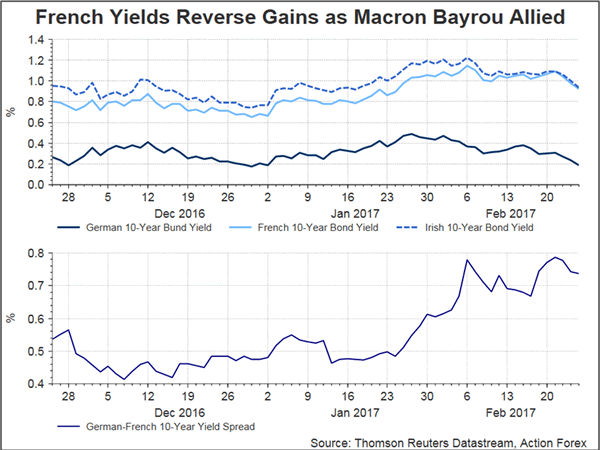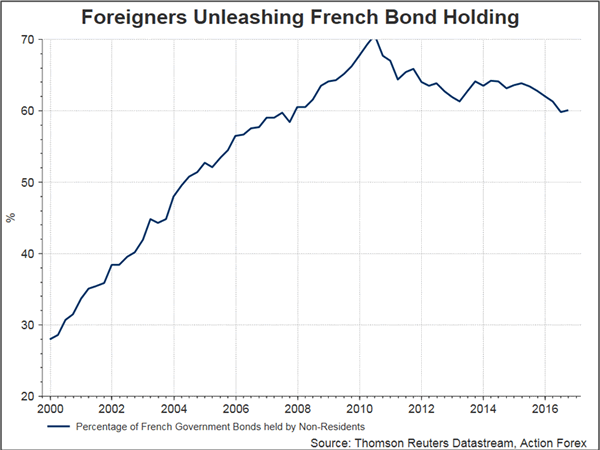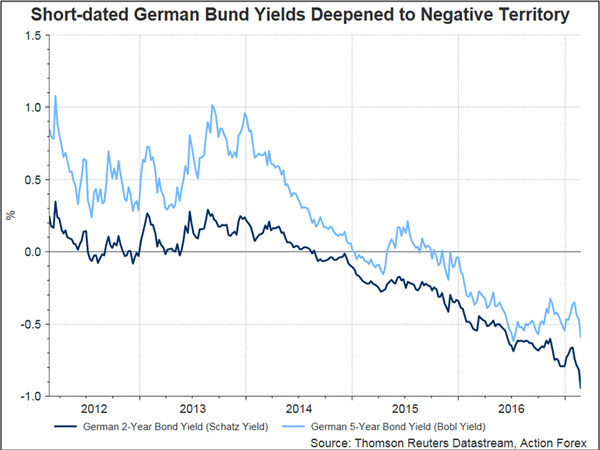Political uncertainty, in particular the French Presidential election, in the Eurozone has unnerved European bond markets. Although far right candidate Marine Le Pen is expected to lose in the second round of the election, the market still finds this tail risk non-negligible. Indeed, recent movements of French bond yields, as well as French-German yield spreads, have been dominated by opinion polls. French yields, as well as French-German yield spreads, climb higher as Le Pen’s supports gain, vice versa. For instance, we notice that France’s 10-year bond yield has started falling since February 22, after veteran centrist Francois Bayrou surprisingly joined Emmanuel Macron in his campaign. Yields continued to drop, falling to a one-month low of 0.92% today, as the latest polls signaled that Macron would beat Le Pen in the second round of presidential elections in May. Simultaneously, French-German yield spreads fell to around 0.72%, the lowest level in a week.


Volatility in the bond markets would remain elevated as we approach the first, and second and final round of the election, to be held on April 23 and May 7, respectively. Latest polls (conducted on Feb 26) by Odoxa/Dentsu showed that supports for Le Pen and Macron in the first round of the election were 27% and 25%, respectively, compared with François Fillon’s 19%. It is expected that Macron would retain 61% of the vote, compared with Le Pen’s 39%, in the second round, making him the French President in the coming 5 years. Separately, polls by Figaro/LCI showed that Macron would be winning the runoff by 58% to 42% for Le Pen. Indeed, even before the Macron-Bayrou alliance, polls have been suggesting Le Pen would lead in first round but lose in the second and final round. While the probability of Le Pen’s victory has been low, the market remained concerned about such risk, especially given the lessons of Brexit referendum and the US presidential election. Of utmost worries are some of the key features in the National Front Party leader’s platform including referendum on France’s EU membership, Bank of France to directly finance the government and redenomination of about 1.7 trillion euro of French public debt into francs.
Concerns over Frexit and redenomination of French debts have triggered selling of French bonds and purchases of German bunds as the latter is regarded as safe haven at times of political uncertainty in the Eurozone. Another phenomenon revealed over the past week was the selloff in Germany’s short-dated bund yields. For instance, Schatz yields plunged to a record low -0.95% while Bobl yields felt o a 7.5-month low of -0.6% last Friday. Undoubtedly, concerns over Frexir and risks over French bond redenomination is a key reason driving bund yields deeper to the negative territory. However, we believe ECB’s move to buy more short-dated debts is a more long-lasting factor pressuring yields.

In December, ECB announced it would lift restrictions on buying debt with yields below the deposit rate of -0.4%. As no guidance on this kind of bond purchases has been provided, how much of these bonds would be bought and when the purchase would begin remains unknown. Danske estimated that15% of the QE purchases in German government bonds would have to be below the deposit level, assuming unchanged bund yields throughout 2017. However, if bund yields increase +25 bps across the curve, the ECB could avoid buying below depo in 2017, while the buying below depo would increase to 40% if yields decrease -25 bps. Citigroup predicts that the ECB will buy around 80B euro of 1-6 year bunds just to complete QE to year-end. While these estimates are based on limited details on ECB’s plan, what is certain is that the move would continue put bund yields, particularly in yields in the 1-6 year segment on the German curve, under pressure.












